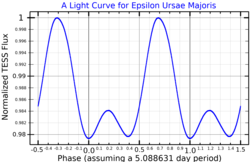Epsilon Ursae Majoris
Epsilon Ursae Majoris or Alioth is a white star in the Ursa Major constellation.
ε Ursae Majoris in Ursa Major (circled). | |
| Observation data Epoch J2000 Equinox J2000 | |
|---|---|
| Constellation | Ursa Major |
| Right ascension | 12h 54m 01.74959s[1] |
| Declination | +55° 57′ 35.3627″[1] |
| Apparent magnitude (V) | 1.77[2] |
| Characteristics | |
| Spectral type | A1III-IVp kB9 |
| U−B color index | +0.02[2] |
| B−V color index | -0.02[2] |
| Variable type | α2 CVn |
| Astrometry | |
| Radial velocity (Rv) | -9.3[3] km/s |
| Proper motion (μ) | RA: +111.91[1] mas/yr Dec.: -8.24[1] mas/yr |
| Parallax (π) | 39.51 ± 0.20[1] mas |
| Distance | 82.6 ± 0.4 ly (25.3 ± 0.1 pc) |
| Absolute magnitude (MV) | –0.2[4] |
| Details | |
| Mass | 2.91[5] M☉ |
| Radius | 4.14[6] R☉ |
| Luminosity | 102[7] L☉ |
| Surface gravity (log g) | 3.23[8] cgs |
| Temperature | 9,020[8] K |
| Metallicity [Fe/H] | +0.00[4] dex |
| Rotational velocity (v sin i) | 33[9] km/s |
| Age | 300[10] Myr |
| Other designations | |
| Database references | |
| SIMBAD | data |
Epsilon Ursae Majoris Media
A light curve for Epsilon Ursae Majoris, plotted from TESS data
Related pages
References
- ↑ 1.0 1.1 1.2 1.3 1.4 van Leeuwen, F. (November 2007), "Validation of the new Hipparcos reduction", Astronomy and Astrophysics, 474 (2): 653–664, arXiv:0708.1752, Bibcode:2007A&A...474..653V, doi:10.1051/0004-6361:20078357, S2CID 18759600
- ↑ 2.0 2.1 2.2 Johnson, H. L.; et al. (1966). "UBVRIJKL photometry of the bright stars". Communications of the Lunar and Planetary Laboratory. 4 (99): 99. Bibcode:1966CoLPL...4...99J.
- ↑ Evans, D. S. (June 20–24, 1966), Batten, Alan Henry; Heard, John Frederick (eds.), "The Revision of the General Catalogue of Radial Velocities", Determination of Radial Velocities and their Applications, Proceedings from IAU Symposium no. 30, University of Toronto: International Astronomical Union, vol. 30, p. 57, Bibcode:1967IAUS...30...57E
- ↑ 4.0 4.1 Tektunali, H. G. (June 1981), "The spectrum of the CR star Epsilon Ursae Majoris", Astrophysics and Space Science, 77 (1): 41–58, Bibcode:1981Ap&SS..77...41T, doi:10.1007/BF00648756, S2CID 122817347
- ↑ Shaya, Ed J.; Olling, Rob P. (January 2011), "Very Wide Binaries and Other Comoving Stellar Companions: A Bayesian Analysis of the Hipparcos Catalogue", The Astrophysical Journal Supplement, 192 (1): 2, arXiv:1007.0425, Bibcode:2011ApJS..192....2S, doi:10.1088/0067-0049/192/1/2, S2CID 119226823
- ↑ Shulyak, D.; Paladini, C.; Causi, G. Li; Perraut, K.; Kochukhov, O. (2014). "Interferometry of chemically peculiar stars: Theoretical predictions versus modern observing facilities". Monthly Notices of the Royal Astronomical Society. 443 (2): 1629. arXiv:1406.6093. Bibcode:2014MNRAS.443.1629S. doi:10.1093/mnras/stu1259. S2CID 96452769.
- ↑ Katarzyński, K.; Gawroński, M.; Goździewski, K. (2016). "Search for exoplanets and brown dwarfs with VLBI". Monthly Notices of the Royal Astronomical Society. 461 (1): 929. arXiv:1608.06719. Bibcode:2016MNRAS.461..929K. doi:10.1093/mnras/stw1354. S2CID 119298606.
- ↑ 8.0 8.1 Gray, R. O.; Corbally, C. J.; Garrison, R. F.; McFadden, M. T.; Robinson, P. E. (2003). "Contributions to the Nearby Stars (NStars) Project: Spectroscopy of Stars Earlier than M0 within 40 Parsecs: The Northern Sample. I". The Astronomical Journal. 126 (4): 2048. arXiv:astro-ph/0308182. Bibcode:2003AJ....126.2048G. doi:10.1086/378365. S2CID 119417105.
- ↑ Royer, F.; et al. (October 2002), "Rotational velocities of A-type stars in the northern hemisphere. II. Measurement of v sin i", Astronomy and Astrophysics, 393 (3): 897–911, arXiv:astro-ph/0205255, Bibcode:2002A&A...393..897R, doi:10.1051/0004-6361:20020943, S2CID 14070763
- ↑ Nakajima, Tadashi; Morino, Jun-Ichi (2012). "Potential Members of Stellar Kinematic Groups within 30 pc of the Sun". The Astronomical Journal. 143 (1): 2. Bibcode:2012AJ....143....2N. doi:10.1088/0004-6256/143/1/2.
